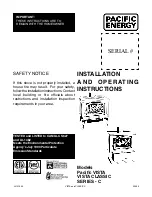
Page 10 |
DURANGO™
Vogelzang International Corp.
TR008 | 20110503.1
cHimNEY coNNEctioNs continued…
Fig. 11 - chimney construction through Attic space
Fig. 12 - chimney construction through Roof
MANUFACTURED ChIMNEY
REFER TO CHIMNEY AND CHIMNEY CONNEC-
TOR MAKER’S INSTRUCTIONS FOR INSTALLATION
AND USE.
Use only 6” diameter listed chimney UL 103 HT.
Chimney made to this listing is High Temperature rated
to 2100 degrees Fahrenheit. Use chimney from only one
manufacturer. Never mix brands. Carefully follow the
chimney manufacturer’s stated requirements and clear-
ances. Use the chimney manufacturer’s attic guards,
roof supports, flashing and fire stops when passing
through a ceiling. Use a listed thimble when passing
through a combustible wall. Do not use makeshift com-
promises during installation. Never use a single-wall
connection pipe as a chimney!
When using a pre-existing chimney, have it’s condi-
tion and installation inspected before using. Make sure
that the chimney meets all of the UL rating requirements
listed above. Be aware that not all manufactured chim-
ney is of the UL 103 HT type.
NOTE: It is recommended that you contact a
licensed heating and cooling contractor (consult your
local yellow pages) for chimney installation.
Manufactured chimney with the proper required UL
listing is available from most home centers, hardware
stores, and HVAC supply stores.
If you have access to the internet, you may wish
to view chimney manufacturers’ information on-line.
See, www.duravent.com, www.selkirkinc.com, or
www.mtlfab.com.
vENTINg TO EXISTINg FIREPLACE
In some instances, people desire to convert an
existing fireplace for stove use. Usually, safe connec-
tion to an existing masonry chimney requires more
work than using a prefabricated chimney. The existing
fireplace must be closed and sealed at the damper with
high-temperature caulk, ceramic wool, or furnace ce-
ment. Prior to installation, clean and inspect the existing
flue and smoke shelf. Installation should be designed
so the system can be dismantled for periodic cleaning
and inspection.
Before conversion, make sure the
existing chimney is structurally sound, the chim
-
ney incorporates a flue liner and make sure it is in
good condition.
(A flue liner consists of clay tile that
protects the brickwork of a chimney. If a chimney does
not have a liner, or it is damaged, have it relined by a
professional.
Do Not use a chimney that is unlined
or damaged!)
If you have any question regarding the
lation must conform to local building and fire codes and
latest edition of NFPA 211.
If there is a clean out opening in the base of the
chimney, close it tightly.
Chimney Minimum height Requirements:
(1) Overall Height – 15 ft. min.
(2) Height above roof – 3 ft
(3) Height above slope – 2 ft. min. within 10 ft.
(4) Minimum rise before horiz. section – 24 in.
NOTICE: If minimum chimney requirements are
not met, your stove will not operate properly.











































